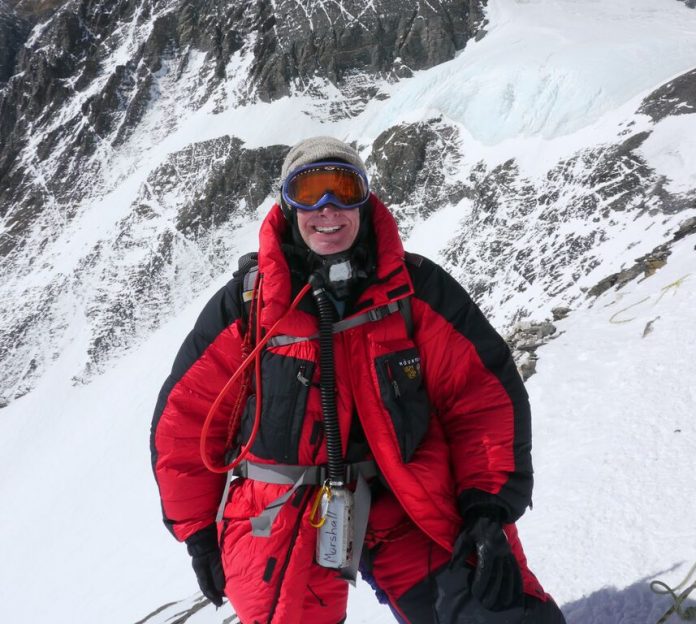
by Marshall Warren
The double sets of balaclavas on my face were frozen. The temperature -30C and the wind light at 20 mph. Just one more step and I will stand on top of the highest mountain, on the coldest, windiest, continent in the world, Antarctica.
And with that last step I will also complete the climbing of the highest point on every continent in the world, “The Seven Summits.” Kilimanjaro (Africa 19,320′), Denali or Mt. McKinley (North America 20,322′), Aconcagua (South America 22,838′), Mt. Everest (Asia 29,035′), Carstensz Pyramid or Puncak Jaya (Australasia 16,024′), Mt. Elbrus (Europe 18,510′) and Mt. Vinson (Antarctica 16050′).
It took me 15 years.
My friends asked me to write an article about my climbs and answer questions that would be interesting so here goes.
Recently on CBS Sunday Morning they had a special on late bloomers – people that didn’t start their famous careers until later in life. Colonel Sanders started KFC and sold his first franchise when he was 62 years old and I didn’t start my Seven Summits climb until I was 46 years old. I guess I am really not a late bloomer in that I married my sweetheart when she was 17 and I was 19. That was 42 years ago. And I started working for Delta Airlines as a pilot at age 24 and that was 36 years ago.
Many of my climbing friends also did not start their major climbs until later in life. To be away for months you need a job where you can be away and the job needs to pay well because a flight to Antarctica on a chartered Russian Ilyushin and all that goes with surviving in such a barren place costs almost $40,000. And a trip to Mt. Everest has a total cost, not including time missed at work, of about $90,000. And I have a room full of climbing gear.
Climbing does many things for me. It has kept me young. At age 60, now I can still run the stadium steps for an hour with a 40-pound pack. When taking two of the biggest breaths I have ever taken, and then take one step and keep that up for 11 1/2 hours while climbing to Camp Three at 24,000 feet on Mt. Everest – I have learned perseverance. Climbing will also make you realize that you live in the greatest country in the world.
In Nepal people are collecting Yak dung for fuel. Stone cutters chisel 12 hours a day in Namche Bazaar – a century’s old trading town in Nepal – to make three stones to use to build a house. In 2000 I left Dallas where it had not rained in two months. In Africa it had not rained for six months and young men were walking all day to fill their five gallon containers of water. And they did it every day.
In New Guinea we saw a family building a fire to boil the salt out of the water so they could sell the salt and provide for the family. They lived in a thatched hut located a several days walk from any human being. When you come home from these sites you cry when you see the American flag. And you enjoy little things like indoor plumbing even more. What price would you pay to feel that feeling of pride? The price has been worth it to me.
It is so important for each of us to set goals and complete them. In climbing your goal maybe as simple as to take one more step or swallow one bite of food. It is hard to eat at high altitude. Your body rejects fats at high altitude and you have no appetite but you must eat thousands of calories each day to climb. I weighed 170 pounds when I went to Mt. Everest and I weighed 146 pounds when I returned. I looked like death with my bones showing through my skin.
Do I get cold on these climbs? Just think, at -40C things start breaking from the cold. At -60, if you dropped a hammer on concrete it would shatter. It’s cold. But not like you know cold. Climbing from Camp One at 19,000 feet on Mt. Everest to Camp Two at 21,000 feet when the sun was shining and the wind was not blowing, it was hot, and I had to carry a snow ball in each hand and one in my hat to keep from overheating.
There it is possible to get sunburn on the roof of your month from the sun reflecting off the snow when you’re breathing hard with an open mouth. On 20,320 foot Denali we were climbing with sunny skies and no wind and I was dressed down so I would not sweat. If you sweat then the next time you stop you will get very cold and if it rains you get wet or worse with lightning. On our Mt Rainier climb, you can get hypothermia in minutes. More people die on Mt. Rainer below 10,000 feet than above 10,000 because of hypothermia.
As we continued to climb Denali the sky became overcast and the wind started blowing and before I knew it my hair was frozen. I know this is strange but I wasn’t cold. When climbing your internal heat is so high you don’t get cold. When climbing you must be very careful since your feeling for cold is reduced. You can get cold and only know it when you start to zip your jacket and your fingers don’t work.
At night in my sleeping bag I have never been cold. I sleep with almost no clothes on. This allows my body heat to warm the air in the bag. One thing that makes that initial plunge into the cold sleeping bag a little easier is that we are always boiling water to melt ice and purify water so we make sure the last heated water is put in a water bottle and placed in our sleeping bag.
I have never been hurt while climbing. Well, my lips are not the ones I have always had. Breathing hard hour after hour, there is no way to protect your lips. Sometimes I’m more successful than others but some of the time it’s so bad my lips grow together during the night. When I get back home I regrow new lips.
I have only had frost nip on my fingers a couple of times. Once you have had cold damage on your fingers it’s easy for it to happen again. When I returned from Mt. Everest I couldn’t feel my fingertips for about a month. Also during that month I had the Khumbu cough. This is a cough that feels like your drowning. It is caused by breathing super cold air. We try to prevent this by always wearing a buff over our month to preheat the air.
The Khumbu is the glacier that makes up the very dangerous ice fall on Mt. Everest where 16 Sherpas died around this time last year – and I knew five of them. A hanging glacier on the upper shoulder of Mt. Everest broke off while they were climbing below it. As it picked up speed and gathered huge rocks it ran over them at high speed. They didn’t have a chance.
During the two months on Mt. Everest I climbed through this area six times. We try and climb in the ice fall when the glacier is not moving. It moves about three feet a day. It moves at night when it is the coldest because ice expands when it freezes and it moves during the day when there is some melting. So we tried to climb during the early morning before the sun touches the glacier. When it moves it is possible for these three- and four-story-high ceracs, or broken ice towers, to fall over.
After summiting Mt. Everest on May 18, 2011 we were making our last trip down through the Khumbu ice fall and I knew something could still happen. We were almost running down while still clipped into the rope for protection. We are always clipped in this area. I was behind Lakpa Rita Sherpa, one of the most famous Sherpas in the world with 14 Mt. Everest summits. He was our Sirdar or head Sherpa.
I saw Lakpa unclip to move faster and so I unclipped and now we were truly running because we both had the same bad feeling. Nothing happened, but when the greatest Sherpa in the world starts running, I’m running.
The closest I have ever been to getting hurt was when I was climbing Aconcagua. We were climbing over a glacier that had a stream running under the ice. This ice melt water heated by the earth rushes under the ice and it sometimes breaks above the surface for a short ways then reenters the glacier. We were climbing above the exposed rushing stream when the entire area we were standing on broke lose and started avalanching into the glacier stream. Another climber and I jumped off the moving ground at the last second before it disappeared back under the glacier. We were an instant away from being pulled under the mountain.
Climbing takes you where most people don’t go. This summer I was in Russia. The troubled country of Ukraine is on the north side of the Black Sea and I was climbing on the east side in the Caucasus, southeast of Sochi where they had the Olympics. We were climbing the highest point in Europe — Mt. Elbrus — at 18,500 feet.
I flew Aeroflot Airlines to St. Petersburg and visited the Hermitage Museum – one of the greatest museums in the world — then flew to southern Russia. It was like going back in time or maybe it was like visiting our small towns in Texas where people abandon them for the big city. Everything was in decay and unfinished.
The people there are like you and I in many ways. Hard working, only wanting the best for their families. People are the same all over the world. Only the governments are different.
In 2013 I walked 60 miles through some of the thickest jungle in the world on the approach to Carstensz Pyramid in Western Papua, Indonesia, a 16,074 foot rock climb and the highest point in the Australasia continent. In most places in the world there are trails because there are large mammals that make the trails. In New Guinea there are no large mammals. So where we hiked there was only a weak point in some of the most dense jungle in the world.
The people there were not discovered until 1938. And except for an airplane crash there in 1942 they were not visited again until the 1950s. In all of history to that point they had not progressed to the extent of even the Copper Age. How would a society progress with no outside influences? They had battles between villages to keep the population down, to decide the village leaders and for entertainment. They believed that the airplanes they saw flying over where people trying to return to a hole in the earth where all mankind came from. The jungle surrounding this valley could not be penetrated from the sea at that time. Can you imagine 80,000 people discovered that the world did not know of until World War II?
On this climb we picked 21 porters to help us. There were 11 men and 10 women. We saw several men only wearing coverings over their private areas. Our porters wore shorts and shirts, the girls wore what looked like the dresses they wore while attending school. They never wore shoes and the porters’ feet were giant. We were not allowed to pick the same porters that were used on a previous climb. They would not allow this because they wanted the money shared to all the people. It also prevented us from properly training them as in Nepal where Sherpas have become the greatest climbers in the world.
As we started our climb some other local men blocked the road wanting us to pay a toll to use their road. They had chopped down trees to block the road and stood with machetes. These days they do not have battles there but they use these conflicts to help decide leaders of the tribes so everyone was allowed to speak.
We had local and USA guides. Local guides are required because the people speak over 1,000 languages there. After one and a half hours the trees were moved and we continued. We were stopped 10 times the first day. The next morning in our camp another village arrived wanting to be our porters and over 100 people came just to look at us.
In this area it rained over an inch everyday. Whatever you think is waterproof – I can assure you we had the best equipment – is only waterproof to a point. Mud went over the tops of our rubber boots each day and we had climbers sink to their hip in mud. We hung our wet clothes in the vestibule of the tent at night. After a night with the temperature in the low 40s we would put the same wet clothes on and wear them until we warmed them up.
While climbing over a 14,000 foot ridge one of our porters died of hypothermia. That was terrible. Climbing well behind us in sudden rain and wind the porter, age 60, got wet and cold. His friends and family tried to carry the man down but it was so steep and muddy they had to leave him. When we reached base camp we were told of the loss.
It was not safe for the porters to climb higher so with little food we climbed down and brought up our needed supplies. We went to sleep about 11 p.m. then woke at 2 a.m. for our climb that turned out to be a 17-hour climb, the longest of any of my climbs. We climbed terrain nearly straight up on granite to a ridge using ropes so worn out that they would not be used in any other part of the world.
After reaching the top of the ridge we had to climb across three breaks in the ridge. One was 60 feet across and almost 1,000 feet down. We broke ice off the used ropes there and crawled across the opening. After the summit we planned to rappel down the granite face but by then the ropes were so wet and they had many knots where the bad parts of the ropes were tied up. It was impossible to rappel.
We had to get down so we used arm wraps. I learned this on Mt. Everest. I know this is going to sound crazy but it works. You wrap the rope around your arm and step off and walk down the mountain. Gravity pushes you against the rock and you walk down. We clip our climbing harness to the climbing rope as a backup so that if you slipped you would only fall to the next point where the rope is connected to the mountain. That would be very painful.
Back at base camp the next morning we waited for the porters to climb up and help with the equipment, but they all had returned to their homes. Now we were 60 miles from where we started, a five-day-walk back. Unable to carry enough food and shelter to return we used our satellite phone to call our Indonesian and USA guide services headquarters. We were advised to not walk out but to go the other way to a local gold and copper mine for help.
It is against Indonesian law for us to go on the mine’s property but we were in an emergency and so we went there to be arrested. We set our tents up on the property of the mine. That night guards armed with automatic rifles visited our camp to get our names. Then they left. Four days later they returned and took us to the Indonesian sheriff. He had side guns, metals, epaulettes and bullets. He was talking to us but we had no idea what he said. Then a lawyer came in and told us about the danger we were in. He said the porter that died was a member of the Donny tribe and they are a warring tribe and they don’t mind fighting the mine, or us, or anybody and they believe in blood for blood.
The mine had decided to reduce their liability by driving us out to the coast. Normally when climbers come on their property they hold them for seven days as a penalty. He said there is one road out and it has been under attack by rebel separatists and 15 people have been killed on this road. They loaded us in the back of two bulletproof vehicles with four armed guards in each vehicle and they drove us the one and a half hours out. We walked across a river bridge back into the coastal town. We were advised to not go out because they didn’t know if Donny family members could be in the town. We flew to Bali the next morning. Then eventually I flew back home to Copper Canyon.
Thank you for your interest in my climbs. I encourage everyone to find his or her Mt. Everest and take that first step. You will be glad you did.
If you want to see some pictures of my climbs, my son-in-law, whom I am very proud to say is the Commanding Officer of his F18 squadron, took my videos and made a YouTube video:
Marshall and Pam Warren have lived in Copper Canyon for 29 years.





















